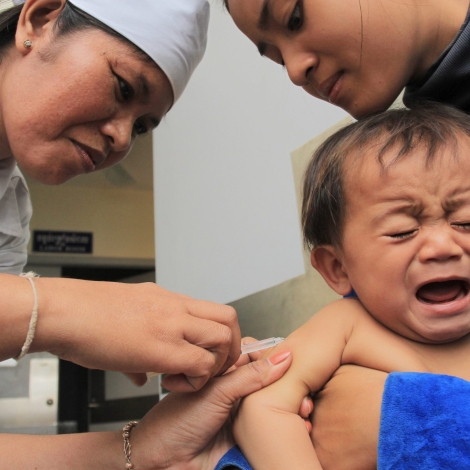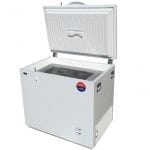Some of the world’s impoverished countries and overlooked, underserved communities are losing the race to vaccinate against the novel coronavirus. They’re paying with lives lost, in many cases owed to supply shortages and planning debacles. But even as supplies become available, delivering vaccines to people who are hard to reach in low-resource settings may require innovative technology. Thoughtful design will be needed in devices such as portable refrigeration to preserve vaccines en route to clinics and to store them on site. Identification technology and medical records keeping for underserved communities can track vaccinations, which may be especially important for two-dose shots. And, of course, planning and investment will be key.
Once the rush to administer the COVID-19 vaccine is over, these same communities could benefit from work to vaccinate against other diseases. Vaccination is a safe and effective healthcare intervention that the World Health Organization endorses, especially in low-resource populations. Worldwide, one in five children miss out on vaccinations for preventable diseases, and better vaccine distribution could prevent 2 million deaths each year, the WHO says.
Crossing “the last mile” is such a well-known challenge that global development practitioners made the term for it. With technologies like those listed here, that journey can be a little easier for healthcare workers.
SunDanzer’s BFRV55 Solar Vaccine Refrigerator
SunDanzer’s BFRV55 is a 55-liter vaccine refrigerator that can store vaccinations off the power grid and in hot climates. The fridge is solar-powered and battery-free technology patented by the US National Aeronautics and Space Administration (NASA) and licensed to SunDanzer. It is designed to work in remote and under-developed areas around the world that have limited or no access to electricity.
E4C Solutions Library: Vaccine Refrigerator BFRV55
 Vaccine Management Using an e-Voucher
Vaccine Management Using an e-Voucher
This digital health device provides access to sanitation services using e-vouchers and can be used to support the COVID-19 vaccination response. Sanitation services may include the provision of items like masks and alcohol wash. E-vouchers are activated following vaccination.
E4C Solutions Library: Coming soon
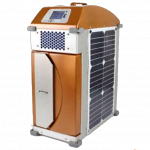 Portable vaccine refrigerator
Portable vaccine refrigerator
This technology combines a Peltier cooling system with vacuum insulation to maintain the vaccine storage compartment at controlled temperatures. The unit can be powered and charged with AC power, on-board battery, vehicle battery, or solar energy. Current battery life, internal temperature, ambient temperature, and alarm states are displayed on the unit LCD. The aggregate data is collected to a cloud server where personnel can monitor and analyze device performance over time.
WHO Compendium of Innovative Health Technologies for Low-Resource Settings (pg 61)
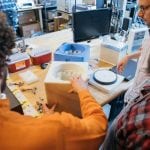 PATH’s “Freeze-Safe” Vaccine Carrier
PATH’s “Freeze-Safe” Vaccine Carrier
PATH has developed a liner for vaccine carriers that stabilizes the temperature of the contents. The “freeze-safe” liner is the first such device to gain WHO approval to prevent freezing or overheating of vaccines during transport.
Freezing can compromise a vaccine’s potency, and health workers often throw out vaccines that they suspect may have suffered temperature damage. The consequence is higher costs to healthcare programs. PATH’s solution places a barrier between the vaccine and ice packs used to regulate the temperature in a vaccine carrier.
E4C Solutions Library: Coming soon
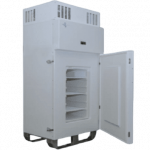 Sure Chill Vaccine Refrigerator BLF100 DC
Sure Chill Vaccine Refrigerator BLF100 DC
The Sure Chill Vaccine Refrigerator is a solar direct-drive refrigerator that can store up to 99 liters of vaccines. The refrigerators regulate their internal temperature and protect vaccine vials from ice to prevent freezing. They keep the vaccines at the appropriate temperature during transport to the communities that need the shots. One of the refrigerator’s innovations is the use of water. It surrounds vaccine vials with cold water to keep it at a more-or-less constant temperature.
E4C Solutions Library: Sure Chill Vaccine Refrigerator
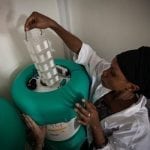 Arktek Passive Vaccine Storage Device
Arktek Passive Vaccine Storage Device
The Arktek Passive Vaccine Storage Device is a passive vaccine storage device that can store up to 5 liters of vaccines, or 300 doses, for more than 35 days. The device, manufactured by Intellectual Ventures Lab, does not require an external power supply and has no complex parts to maintain or install.
With a single load of ice blocks the Arktek PSD maintains vaccine-appropriate temperatures of 0-10°C in ambient temperatures of up to 43°C. With monthly ice replacements, the device can serve a community of about 6000 people. The vaccine carrier is vacuum-insulated to allow repeated retrievals. It also includes a monitor that tracks location, internal temperature, and the number of retrievals, then transmits the information through a USB connection or over SMS messaging.
E4C Solutions Library: Arktek Passive Vaccine Storage Device
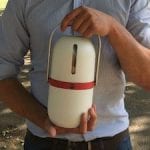 Isobar Portable Vaccine Refrigerator
Isobar Portable Vaccine Refrigerator
Isobar is a portable, battery-operated refrigerator that keeps vaccines at an ideal temperature in the range of 2-8˚C for up to 30 days. The device is a prototype in development with support by the University of Luxembourg.
The refrigerator works on the principal of Einstein’s refrigeration system developed in 1906. Ammonia is the refrigerant, and two-phase refrigeration creates the cooling effect. A propane burner or electric heater separates the vapors of ammonia and water to cool the inner chamber.
E4C Solutions Library: Isobar Portable Vaccine Refrigerator
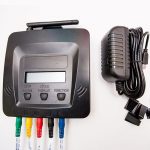 Nexleaf ColdTrace
Nexleaf ColdTrace
Nexleaf ColdTrace is a wireless remote temperature monitoring device for vaccine refrigerators. The device uses temperature sensor probes to collect data, which it analyzes and transmits. When vaccines are at risk of overheating or freezing, ColdTrace sends alerts via SMS.
E4C Solutions Library: Nexleaf ColdTrace
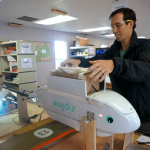 Zipline
Zipline
Zipline uses fixed wing drones to remotely deliver vaccines medicines and supplies.
Zipline is a delivery drone manufacturer that specializes in deliveries of medical supplies, including vaccines, to remote locations. The fixed-wing delivery drones, which the company calls “Zips,” can operate under most weather conditions. As of now, Zips serve 13,000 people at 21 hospitals in Rwanda and 2000 facilities in Ghana.
The Zip does not require a landing site at the delivery location. Instead, it drops its payload to let it parachute into a landing zone, then returns to the distribution depot.
E4C Solutions Library: Zipline
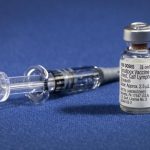 Temperature-Stable Vaccines
Temperature-Stable Vaccines
Vaccines that require refrigeration are easier to store and transport than those that require freezing, but for remote locations, room temperature is best. Researchers are working on thermostable COVID-19 vaccines that won’t need refrigeration. Techniques that remove the need for a vaccine cold chain have been used for many decades with success. Freeze-dried vaccines are one such example. The first thermostable vaccine was developed for smallpox in 1955 and is credited in part with the ultimate elimination of the disease.
Today, researchers continue to look for innovative ways to stabilize viral vaccines: from air-drying with low-cost sugar films to freeze-drying with different stabilizing agents. Some researchers are also working on stable liquid formulations, in particular live attenuated flu viruses, that avoid the costly process of freeze-drying, which is not always easy for low- and middle-income countries to do. All these approaches could be applicable to live virus vaccines that use an attenuated virus, just like the flu vaccine, as well as both of the coronavirus vaccines by AstraZeneca and Johnson & Johnson.
